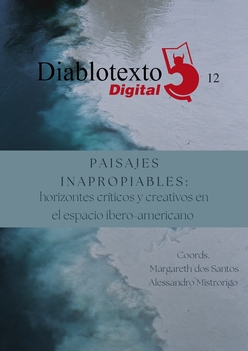Paraná r'anga. The Amphibious Perforation of the Landscape
DOI:
https://doi.org/10.7203/diablotexto.12.25391Keywords:
Nature, landscape, figure, travel Abstract
Abstract
The book, Paraná Ra’anga, is one of the results of a two-year project (2008-2010), a one-month journey down the Paraná River, from Buenos Aires (Argentina) to Asunción (Paraguay). This journey was imagined as a replica of Ulrico Schmidl’s 16th-century expedition, as well as a reference to the travels of 19th -century nature scientists. The book is a constellation, from diverse approaches, of figures whose common denominator is the conviction that the disappearance of the river is imminent, due to the current policies of agricultural and animal-farming economy and to the conversion of the river into an “hidrovía” (waterway). These figures are marked by the experience of loss of both spatial and time references and by a series of modulations of the relation between observer and nature establishing a dialogue with the tradition of the landscape.
 Downloads
Downloads
 References
References
AGUILÓ, Miguel y GONZÁLEZ ALONSO, Santiago (2011). “Remontar el Paraná y aprender sobre paisajes…”. En Graciela Silvestri (ed.), Paraná Ra’anga. Un viaje filosófico. Rosario: CCPE / Barcelona: Altaïr, pp.176-179.
ANDERMANN, Jens (2018). Tierras en trance. Arte y naturaleza después del paisaje. Santiago de Chile: Metales pesados.
AUERBACH, Erich [1938] (1998). Figura. Madrid: Trotta.
DIDI-HUBERMAN, Georges [1992] (2011). Lo que vemos, lo que nos mira. Buenos Aires: Manantial.
FORSTER, Sergio (2011). “Un viaje sin referencias”. En Graciela Silvestri (ed.), Paraná Ra’anga. Un viaje filosófico. Rosario: CCPE / Barcelona: Altaïr, pp. 50-53.
GARCÍA HELDER, Daniel; MORENO, María; PRIETO, Martín y SILVESTRI, Graciela (2011). “Diario de bitácora”. En Graciela Silvestri (ed.), Paraná Ra’anga. Un viaje filosófico. Rosario: CCPE / Barcelona: Altaïr, pp.67-172.
GARCÍA, Susana V. y PODGRONDNY, Irina (2011). “Una fuente de fósiles y controversias”. En Graciela Silvestri (ed.), Paraná Ra’anga. Un viaje filosófico. Rosario: CCPE / Barcelona: Altaïr, 203-207.
JAY, Martin [1997] (2007). Ojos abatidos. La denigración de la visión en el pensamiento francés del siglo XX. Madrid: Akal.
LLINÁS, Mariano (2011). “Un experimento con el río”. En Graciela Silvestri (ed.), Paraná Ra’anga. Un viaje filosófico. Rosario: CCPE / Barcelona: Altaïr, pp. 253-257.
MACCIONI, Franca (2019). “El mismo río, dos veces. Repetición y recomienzo en Ulrico Schmidl y Paraná Ra’anga”. En Paula La Rocca y Ana Neuburger (comp.), Figuras de la intemperie. Panorámica de estéticas contemporáneas. Córdoba: Universidad Nacional de Córdoba, pp. 51-75.
MEITIN, Alejandro (2019). La Tierra NO Resistirá. Buenos Aires: CasaRío.
MELIÀ, Bartomeu (2011). “Paisaje guaraní”. En Graciela Silvestri (ed.), Paraná Ra’anga. Un viaje filosófico. Rosario: CCPE / Barcelona: Altaïr, 188-201.
MILONE, Gabriela (2019). “Pensar por figuras”. En Paula La Rocca y Ana Neuburger (comp.), Figuras de la intemperie. Panorámica de estéticas contemporáneas. Córdoba: Universidad Nacional de Córdoba, pp. 19-33.
PANOFSKY, Erwin [1927] (2003). La perspectiva como “forma simbólica”. Barcelona: Tusquets.
PRIETO, Martín (2011). “De una manera u otra”. En Graciela Silvestri (ed.), Paraná Ra’anga. Un viaje filosófico. Rosario: CCPE / Barcelona: Altaïr, pp. 26-27.
SILVESTRI, Graciela (2021). Las tierras desubicadas: Paisajes y culturas en la Sudamérica fluvial. Paraná: Universidad Nacional de Entre Ríos, UNER, Aura.
SILVESTRI, Graciela (editora) y PRIETO, Martín (idea) (2011). Paraná Ra’anga. Un viaje filosófico. Rosario: CCPE / Barcelona: Altaïr.
SILVESTRI, Graciela (2011). “La historia de una idea”. En Graciela Silvestri (ed.), Paraná Ra’anga. Un viaje filosófico. Rosario: CCPE / Barcelona: Altaïr; pp. 30-37.
SILVESTRI, Graciela y RIVAROLA, Milda (2011). “El testimonio de los viajeros”. En Graciela Silvestri (ed.), Paraná Ra’anga. Un viaje filosófico. Rosario: CCPE / Barcelona: Altaïr, pp. 272-285.
SILVESTRI, Graciela (2011a). El lugar común. Una historia de las figuras de paisaje en el Río de La Plata. Buenos Aires: Edhasa.
SILVESTRI, Graciela (2003). El color del río. Historia cultural del paisaje del Riachuelo. Buenos Aires: Universidad Nacional de Quilmes/ Prometeo.
SILVESTRI, Graciela (2002). “La pampa y el río. Una hipótesis de registros y periodizaciones en el paisaje rioplatense”, Materia. Revista Internacional d’Art, n.º 2, pp. 75-96.
SILVESTRI, Graciela y ALIATA, Fernando (2001). El paisaje como cifra de armonía. Relaciones entre cultura y naturaleza través de la mirada paisajística. Buenos Aires: Nueva Visión.
SIMMEL, Georg [1913] (2013). Filosofía del paisaje. Madrid: Casimiro.
SIRACUSANO, Gabriela (2011). “El espesor de las imágenes jesuíticas guaraníes en la expedición Paraná R’anga”. En Graciela Silvestri (ed.), Paraná Ra’anga. Un viaje filosófico. Rosario: CCPE / Barcelona: Altaïr, 208-219.
STAROBINSKY, Jean [1961] (2002). El ojo vivo. Valladolid: Cuatro ediciones.
STEYERL, Hito [2012] (2014). Los condenados de la pantalla. Buenos Aires: Caja Negra, pp. 15-32
Downloads
Published
How to Cite
-
Abstract373
-
PDF (Español)219
Issue
Section
License
Licencia de reconocimiento de Creative Commons “Reconocimiento - No Comercia l- Sin Obra Derivada
Authors who publish with this journal agree to the following items:
The authors will keep their copyright and guarantee the journal the right of first publication of their work, which will be simultaneously subject to the Creative Commons license that allows third parties to share the work indicating its author and its first publication in the journal. The authors may adopt other non-exclusive license agreements to distribute the version of the published work (e.g., depositing it in an institutional telematic file or publishing it in a monographic volume), with an acknowledgment of its initial publication in this journal. The authors are allowed and encouraged to disseminate their work through the Internet (e.g., in institutional telematic archives or on their website) before and during the submission process, which can produce interesting exchanges and increase citations of the published work. (See Effect of Open Access)




